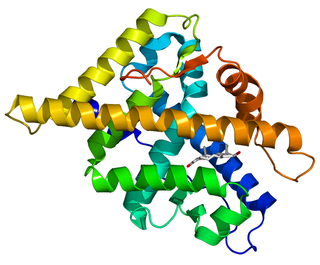The testicular receptor 2 (TR2) also known as NR2C1 (nuclear receptor subfamily 2, group C, member 1) is protein that in humans is encoded by the NR2C1 gene. [5] [6] TR2 is a member of the nuclear receptor family of transcription factors.
The testicular receptor 2 (TR2) also known as NR2C1 (nuclear receptor subfamily 2, group C, member 1) is protein that in humans is encoded by the NR2C1 gene. [5] [6] TR2 is a member of the nuclear receptor family of transcription factors.
Testicular receptor 2 has been shown to interact with:

The androgen receptor (AR), also known as NR3C4, is a type of nuclear receptor that is activated by binding any of the androgenic hormones, including testosterone and dihydrotestosterone in the cytoplasm and then translocating into the nucleus. The androgen receptor is most closely related to the progesterone receptor, and progestins in higher dosages can block the androgen receptor.

Histone deacetylase 1 (HDAC1) is an enzyme that in humans is encoded by the HDAC1 gene.

The nuclear receptor co-repressor 2 (NCOR2) is a transcriptional coregulatory protein that contains several nuclear receptor-interacting domains. In addition, NCOR2 appears to recruit histone deacetylases to DNA promoter regions. Hence NCOR2 assists nuclear receptors in the down regulation of target gene expression. NCOR2 is also referred to as a silencing mediator for retinoid or thyroid-hormone receptors (SMRT) or T3 receptor-associating cofactor 1 (TRAC-1).
The testicular receptor proteins are members of the nuclear receptor family of intracellular transcription factors. There are two forms of the receptor, TR2 and TR4, each encode by a separate gene.

Peroxisome proliferator-activated receptor gamma, also known as the glitazone receptor, or NR1C3 is a type II nuclear receptor that in humans is encoded by the PPARG gene.

RAR-related orphan receptor alpha (RORα), also known as NR1F1 is a nuclear receptor that in humans is encoded by the RORA gene. RORα participates in the transcriptional regulation of some genes involved in circadian rhythm. In mice, RORα is essential for development of cerebellum through direct regulation of genes expressed in Purkinje cells. It also plays an essential role in the development of type 2 innate lymphoid cells (ILC2) and mutant animals are ILC2 deficient. In addition, although present in normal numbers, the ILC3 and Th17 cells from RORα deficient mice are defective for cytokine production.

Estrogen receptor beta (ERβ), also known as NR3A2, is one of two main types of estrogen receptor, a nuclear receptor which is activated by the sex hormone estrogen. In humans, ERβ is encoded by the ESR2 gene.

Histone deacetylase 2 (HDAC2) is an enzyme that in humans is encoded by the HDAC2 gene. It belongs to the histone deacetylase class of enzymes responsible for the removal of acetyl groups from lysine residues at the N-terminal region of the core histones. As such, it plays an important role in gene expression by facilitating the formation of transcription repressor complexes and for this reason is often considered an important target for cancer therapy.

Histone deacetylase 3 is an enzyme encoded by the HDAC3 gene in both humans and mice.

Retinoic acid receptor alpha (RAR-α), also known as NR1B1 is a nuclear receptor that in humans is encoded by the RARA gene.

Paired amphipathic helix protein Sin3a is a protein that in humans is encoded by the SIN3A gene.

Histone deacetylase 4, also known as HDAC4, is a protein that in humans is encoded by the HDAC4 gene.

Liver X receptor alpha (LXR-alpha) is a nuclear receptor protein that in humans is encoded by the NR1H3 gene.

Nuclear receptor-interacting protein 1 (NRIP1) also known as receptor-interacting protein 140 (RIP140) is a protein that in humans is encoded by the NRIP1 gene.

Estrogen-related receptor gamma (ERR-gamma), also known as NR3B3, is a nuclear receptor that in humans is encoded by the ESRRG gene. It behaves as a constitutive activator of transcription.

Estrogen-related receptor alpha (ERRα), also known as NR3B1, is a nuclear receptor that in humans is encoded by the ESRRA gene. ERRα was originally cloned by DNA sequence homology to the estrogen receptor alpha, but subsequent ligand binding and reporter-gene transfection experiments demonstrated that estrogens did not regulate ERRα. Currently, ERRα is considered an orphan nuclear receptor.

Testicular receptor 4 also known as NR2C2 is a protein that in humans is encoded by the NR2C2 gene.

Herpesvirus entry mediator (HVEM), also known as tumor necrosis factor receptor superfamily member 14 (TNFRSF14), is a human cell surface receptor of the TNF-receptor superfamily.

Sin3A-associated protein, 30kDa, also known as SAP30, is a protein which in humans is encoded by the SAP30 gene.

Speckle-type POZ protein is a protein that in humans is encoded by the SPOP gene.
| This article on a gene on human chromosome 12 is a stub. You can help Wikipedia by expanding it. |